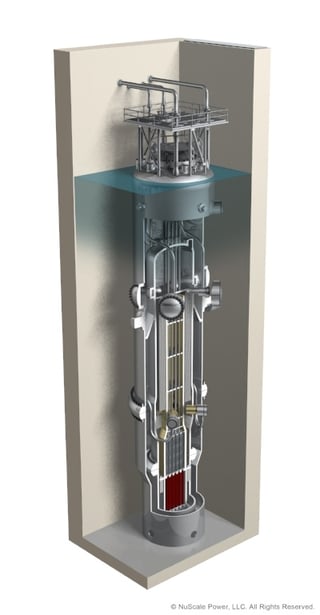This post is one in a series featuring the complete slate of advanced energy technologies outlined in the report This Is Advanced Energy. Image courtesy of NuScale Power.

Small modular reactors (SMRs) are small-footprint nuclear power plants that can be sized between 10 MW and 300 MW. There are numerous SMR plant designs, although SMRs all rely on the same nuclear fission technology used by larger plants. Nuclear fission releases heat in the reactor core that is used to produce steam, which spins a steam turbine attached to an electric generator. Unlike utility-scale plants, which are difficult to site and can take years to construct, SMRs are designed to have many components fabricated and assembled offsite, thus reducing the time and complexity of plant construction and increasing potential plant locations. SMR designs generally have their reactors buried in the ground away from weather hazards, and are often designed to use passive cooling systems that are not vulnerable to power outages, further increasing the safety of the plant.
The basic design for SMRs is similar to the nuclear reactors that have been powering submarines for decades. While only four projects have reached the construction phase worldwide, there are projects under consideration in the United States, such as a potential Tennessee Valley Authority development in Oak Ridge, Tennessee. NuScale is engaging with the Nuclear Regulatory Commission (NRC) to put 12 SMRs into operation with a total capacity of 540 MW. The company estimates that its rst SMR plant will be online in 2023. In addition, Holtec SMR is in the pre-application process with the NRC to deploy its SMR-160 model, which has an output of 160 MW. General Electric and Hitachi have partnered to commercialize a 311 MW SMR called the Power Reactor Innovative Small Modular, or PRISM, which will utilize nuclear waste as a fuel source.
SMRs could ease congestion and provide grid reliability if strategically sited to meet grid needs. The use of factory fabrication for most major components and the potential for shorter and less complex construction compared to large-scale plants may reduce capital costs relative to large nuclear reactors. The Department of Energy has estimated the levelized cost of electricity (LCOE) from SMRs could eventually be as low as $55/ MWh. For comparison, Lazard estimates a LCOE of $92-132/MWh for new large-scale nuclear plants and $66-151/MWh for new coal- red units, including carbon capture at the upper bound. Financing for large-scale plants has proven a challenge due to the large investments needed (several billion dollars per plant) and the long timeframe (about a decade). SMRs would require smaller investments and have shorter development times, which would reduce investment risk and make financing easier.
